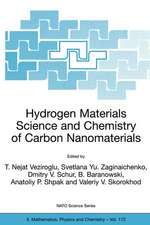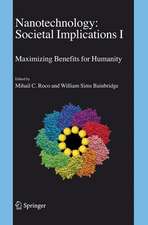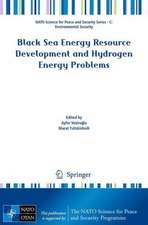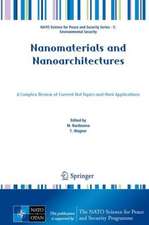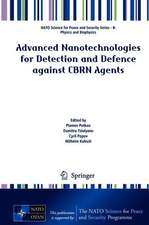Carbon Nanomaterials in Clean Energy Hydrogen Systems - II: NATO Science for Peace and Security Series C: Environmental Security
Editat de Svetlana Yu. Zaginaichenko, Dmitry V. Schur, Valeriy V. Skorokhod, Ayfer Veziroğlu, Beycan İbrahimoğluen Limba Engleză Paperback – 6 mai 2011
| Toate formatele și edițiile | Preț | Express |
|---|---|---|
| Paperback (1) | 1225.31 lei 6-8 săpt. | |
| SPRINGER NETHERLANDS – 6 mai 2011 | 1225.31 lei 6-8 săpt. | |
| Hardback (1) | 1236.51 lei 6-8 săpt. | |
| SPRINGER NETHERLANDS – 28 apr 2011 | 1236.51 lei 6-8 săpt. |
Din seria NATO Science for Peace and Security Series C: Environmental Security
- 18%
 Preț: 1106.00 lei
Preț: 1106.00 lei - 15%
 Preț: 659.70 lei
Preț: 659.70 lei - 18%
 Preț: 999.60 lei
Preț: 999.60 lei - 18%
 Preț: 1221.07 lei
Preț: 1221.07 lei - 18%
 Preț: 1220.75 lei
Preț: 1220.75 lei - 18%
 Preț: 940.39 lei
Preț: 940.39 lei - 18%
 Preț: 1216.78 lei
Preț: 1216.78 lei - 18%
 Preț: 1232.71 lei
Preț: 1232.71 lei - 18%
 Preț: 1818.02 lei
Preț: 1818.02 lei - 18%
 Preț: 1833.95 lei
Preț: 1833.95 lei - 18%
 Preț: 1231.47 lei
Preț: 1231.47 lei - 18%
 Preț: 942.44 lei
Preț: 942.44 lei - 18%
 Preț: 1218.06 lei
Preț: 1218.06 lei - 18%
 Preț: 1383.00 lei
Preț: 1383.00 lei - 15%
 Preț: 664.29 lei
Preț: 664.29 lei - 18%
 Preț: 1220.88 lei
Preț: 1220.88 lei - 24%
 Preț: 1040.01 lei
Preț: 1040.01 lei - 18%
 Preț: 1222.80 lei
Preț: 1222.80 lei - 18%
 Preț: 1220.75 lei
Preț: 1220.75 lei - 18%
 Preț: 1224.85 lei
Preț: 1224.85 lei - 18%
 Preț: 1224.85 lei
Preț: 1224.85 lei - 18%
 Preț: 1224.68 lei
Preț: 1224.68 lei - 18%
 Preț: 963.15 lei
Preț: 963.15 lei - 18%
 Preț: 1229.10 lei
Preț: 1229.10 lei - 18%
 Preț: 1222.49 lei
Preț: 1222.49 lei - 18%
 Preț: 1223.74 lei
Preț: 1223.74 lei - 18%
 Preț: 1213.65 lei
Preț: 1213.65 lei - 18%
 Preț: 956.33 lei
Preț: 956.33 lei - 18%
 Preț: 1235.43 lei
Preț: 1235.43 lei - 18%
 Preț: 940.39 lei
Preț: 940.39 lei - 18%
 Preț: 1210.63 lei
Preț: 1210.63 lei - 18%
 Preț: 1219.63 lei
Preț: 1219.63 lei - 18%
 Preț: 1225.48 lei
Preț: 1225.48 lei - 18%
 Preț: 1228.75 lei
Preț: 1228.75 lei - 18%
 Preț: 1228.62 lei
Preț: 1228.62 lei - 18%
 Preț: 1222.94 lei
Preț: 1222.94 lei - 18%
 Preț: 962.98 lei
Preț: 962.98 lei - 18%
 Preț: 1218.06 lei
Preț: 1218.06 lei - 15%
 Preț: 643.99 lei
Preț: 643.99 lei - 18%
 Preț: 1220.12 lei
Preț: 1220.12 lei - 18%
 Preț: 1233.52 lei
Preț: 1233.52 lei - 18%
 Preț: 946.24 lei
Preț: 946.24 lei - 18%
 Preț: 1218.21 lei
Preț: 1218.21 lei - 18%
 Preț: 953.65 lei
Preț: 953.65 lei
Preț: 1225.31 lei
Preț vechi: 1494.28 lei
-18% Nou
Puncte Express: 1838
Preț estimativ în valută:
234.46€ • 244.79$ • 194.05£
234.46€ • 244.79$ • 194.05£
Carte tipărită la comandă
Livrare economică 04-18 aprilie
Preluare comenzi: 021 569.72.76
Specificații
ISBN-13: 9789400709010
ISBN-10: 9400709013
Pagini: 576
Ilustrații: XXXIV, 540 p. 278 illus.
Dimensiuni: 155 x 235 x 33 mm
Greutate: 0.66 kg
Ediția:2011
Editura: SPRINGER NETHERLANDS
Colecția Springer
Seria NATO Science for Peace and Security Series C: Environmental Security
Locul publicării:Dordrecht, Netherlands
ISBN-10: 9400709013
Pagini: 576
Ilustrații: XXXIV, 540 p. 278 illus.
Dimensiuni: 155 x 235 x 33 mm
Greutate: 0.66 kg
Ediția:2011
Editura: SPRINGER NETHERLANDS
Colecția Springer
Seria NATO Science for Peace and Security Series C: Environmental Security
Locul publicării:Dordrecht, Netherlands
Public țintă
GraduateCuprins
Problems of Development of Hydrogen Power Engineering.- Materials Containing Carbon Nanoparticles for Hydrogen Power Engineering.- About Fe-Graphite-H Phase Diagram Like a Scientific Base of Hydrogen Storages and Hydrogen Membranes.- Special Features and Regularities of Interaction between Fullerene Molecules and Aromatic Solvents.- Fullerene Molecule as Catalyst of Synthesis of Carbon Nanotubes.- Formation and Properties of Magnetic Nanocrystallites Embedded in Carbon Beads- Hydrogenation of Fullerite C₆₀ in Gaseous Phase.- Carbon Nano/Microstructures for Hybrid Hydrogen Storage Based on Specially Treated Carbon Fibers.- Cyclic Hydrocarbon Decomposition to Carbon Nanoparticles Via Spark Discharge.- Encapsulated Ferromagnetic Nanoparticles in Carbon Shells.- The Peculiarities of Nanostructures Formation in Liquid Phase.- The Temperature Dependence of Chemical Shifts of Individual Peaks in the 13C NMR Spectrum of the Fullerite C₆₀, Doped with Molecular Oxygen.- Synthesis of Carbon Nanotubes on Zirconium Alloys Surface.- Small Size Particles of Different Metal Alloys with Protective Shell for Hydrogen Storage.- CVD-Synthesis Peculiarities of Carbon Nanomaterials from Ethylene with Gaseous Additions.- Carbon Nanotubes Filled Composite Materials.- Analysis of the Interrelation of the Thermal Stability of Hydrides of the Intermetallic Compounds of Composition AB₂ with the Nature of their Chemical Bonds Character Me – H.- Molecular-Kinetic Theory of Phase Transitions in Crystals of Fluorofullerenes C₆₀F₄₈ → C₆₀F₃₆ and their Heat Capacity.- The Designed Metal-Hydride Torches and Hydrogen Accumulators forVarious Purposes.- Electric Field Gradients at Hydrogen and Metal Sites in Light Metal Hydrides.- Polymer Membranes for Fuel Cells: Achievements and Problems.- Neutron Studies of Nanoscale Fullerenes and Fullerene Hydrides.- Electronic Structures of Fullerene C₆₀ Derivative: DFT Modeling.- New Substances: Red Carbon Suboxide (C.> ₅,₄O), Red Molecular Crystals of Closed Nitrogen-Oxygen Molecules (C₅₀N₁₀O₃H₁₀) and “Red Carbon”.- Source of Ultraviolet Radiation with Field-Emission Cathode Made of Nanostructured Carbon Material.- Hydrogen Desorption Temperature and its Storage in Cylindrical and Plane Graphene-Based Carbon Nanostructures. A Comparative Analysis with Nanocrystallites-Based Carbon Nanostructures.- Temperature Ferroelastic Phase Transition in Hydroxyapatite Ca₅ (PO₄)₃OH. Solubility of Hydroxyl. Hysteresis Effect. Elastic Compliance and Modulus of Elasticity. Configuration Heat Capacity.- The Theory of Phase Transformations and Heat Capacity in Crystals of Fluorofullerenes.- Heat Stability of Me-C Nanocomposites.- [C₇₆] – Fullerenes: Enumeration of Isomer Substitutions in Terms of Apical, Edge and Face Differentiation.- Carboranes and Boranes: Enumeration of Isomer Substitutes and Property Calculation Schemes on the Basis of Pascal Triangle.- Thermodynamic Properties and Phase Equilibriums in Ternary Alloys of the Al-C-3D-Metal Systems.- The Agreement Phenomenon of the Component Analysis with Dimensions of the Graphenic-Like Carbon and Boron Nitride Nanosized Particles.- Utilizing the Waste Heat of SOFC by Newly Developed Cogeneration System.- NMR Investigations of Hydrogen Intercalates in GaSeLayered Crystals.- Nanomaterials as a New Eco-Threat: Chemical and Nanotoxicological Peculiarities.- The Structural Properties of the sp¹-Carbon Based Materials: Linear Carbon Chains, Carbyne Crystals and a New Carbon Material – Two Dimensional Ordered Linear-Chain Carbon.- Internal Stresses and Hydrogen Permeability of Hollow Cylinder.- The Platinum Catalyst for Micro Fuell Cells on the Basis of Silicon.- Studies of Hydrogen Sorption on Mesoporous Carbon Composite Modified with Adsorbed Palladium.- Thermodynamic Properties and Phase Equilibriums in Ternary Alloys of the Al-C-Si(Ge, Sn, Pb) Systems.- Increase of Solubility of Hydrogen in Electrolytic Alloys Ni-B.- Laws of Diffusion of Hydrogen in Electrolytic Alloys on the Basis of Nickel.
Textul de pe ultima copertă
This book presents selected contributions to the NATO Advanced Research Workshop “Carbon Nanomaterials in Clean Energy Hydrogen Systems” held in June 2010. These original papers reflect recent progress in response to the modern-day requirements in chemistry of carbon nanomaterials and metal-hydrogen systems. Successor to the 2008 proceedings, this second volume focuses on research and application studies of materials capable of interacting actively with hydrogen, also addressing questions of hydrogen accumulation and storage. As a whole, it provides a review of the most relevant areas of hydrogen materials interactions and carbon nanomaterials science, making it invaluable for all researchers, physicists, chemists, post-graduates and young scientists interested in the structure, properties and applications of different nanocarbon materials.
Caracteristici
Hydrogen is the most suitable energy carrier and source, because it is of greatest abundance and ecologically clean The energetic sources, allowed the hydrogen production in the industrial quantities are presented in this book Various advanced materials and technologies of their synthesis are considered Includes supplementary material: sn.pub/extras







